Chicken Stock | Broth For Baby | Kids | GAPS Friendly
A true homemade chicken stock (or bone broth) starts with whole food: bones, cartilage and sometimes is flavored with added vegetables and herbs. Making a chicken stock for baby is no different, but it’s very low in sodium (no added salt). Use the chicken stock/broth for baby food starting from 6 months – as the starring ingredient in soups (especially chicken soup) as the boiling liquid when preparing chicken recipes for babies , and as the staple food when doing GAPS diet for babies and GAPS for older kids.
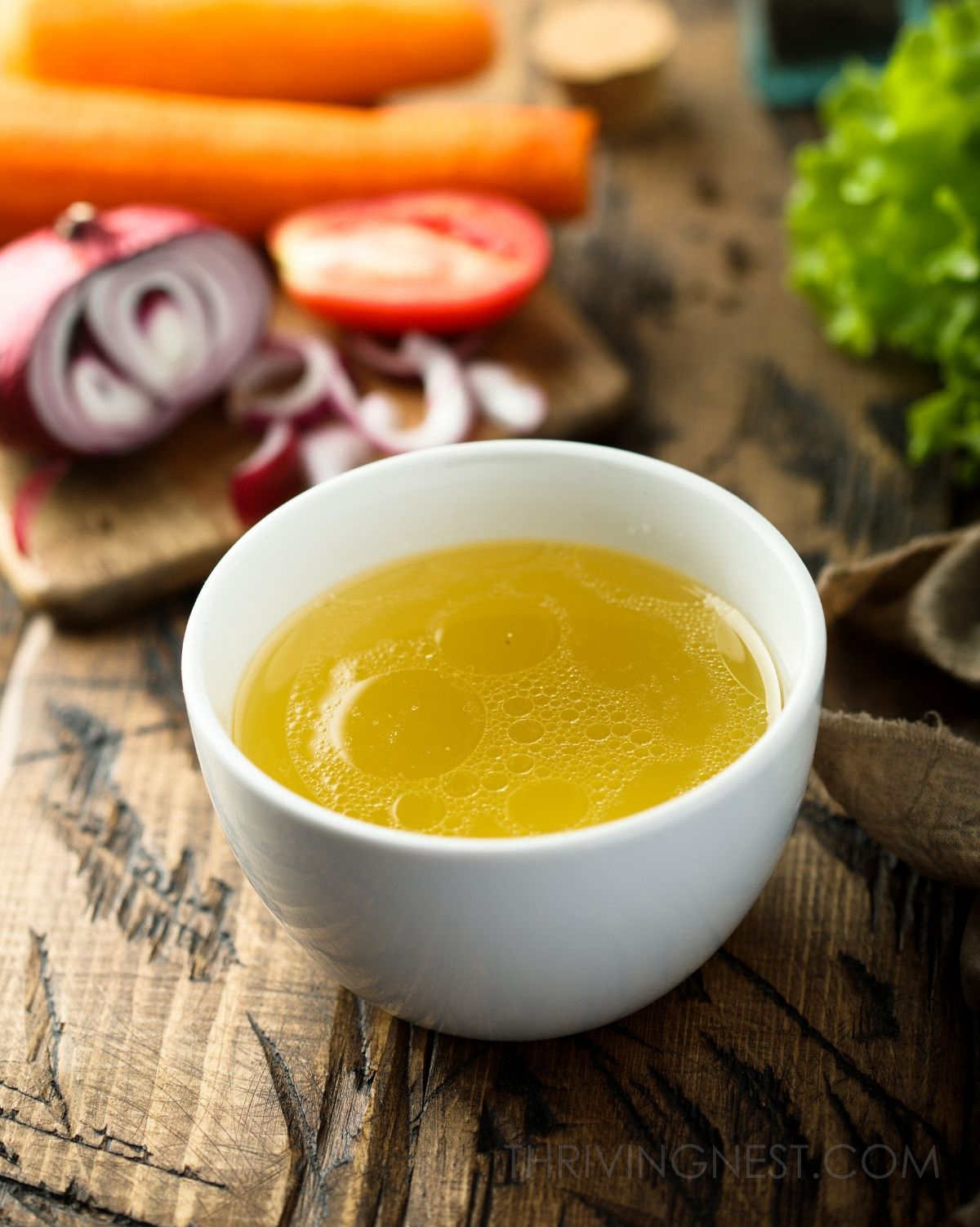
Due to its mineral, protein and collagen rich formula the stock (or bone broth) makes particularly impressive nutritional source for growing babies.
These days, making homemade broth seems to be an outdated practice, given the abundance of boxed and canned alternatives available on grocery shelves. But keep in mind that these cheap products like bouillon cubes, dehydrated soup and most boxed soups are full of unhealthy ingredients like monosodium glutamate(MSG), hydrogenated oils and artificial flavors – all which have been found to be toxic by research. If you value your and your baby’s health, always try to make a stock / broth from scratch with organic ingredients.
Bone Broth For Babies
The extra essential fatty acids, calcium, magnesium, and other minerals that leach out of the animal bones while simmering are important for human bone and muscle health. There is evidence that the collagen in bone broth and stocks made with bones may also help support the gut lining. According to Dr. Natasha Campbell-McBride, the proponent of GAPS Nutritional Protocol, specialized in digestive and immune disorders, the chicken meat and bone stock is especially beneficial for kids struggling with gut inflammation, digestive discomfort and skin issues like eczema. I have a detailed post specifically about GAPS Diet for babies who are still breastfed and need to be introduced to solids.
According to Dr. Campbell-McBride the meat stock (with bones) is less harsh on small babies that have a compromised digestive system and easier to digest. The bone broth on the other hand has more complex components and is richer in histamine, and might bee too strong for a sensitive gut dealing with allergies and eczema. When more healing is achieved, you can advance to bone broth.
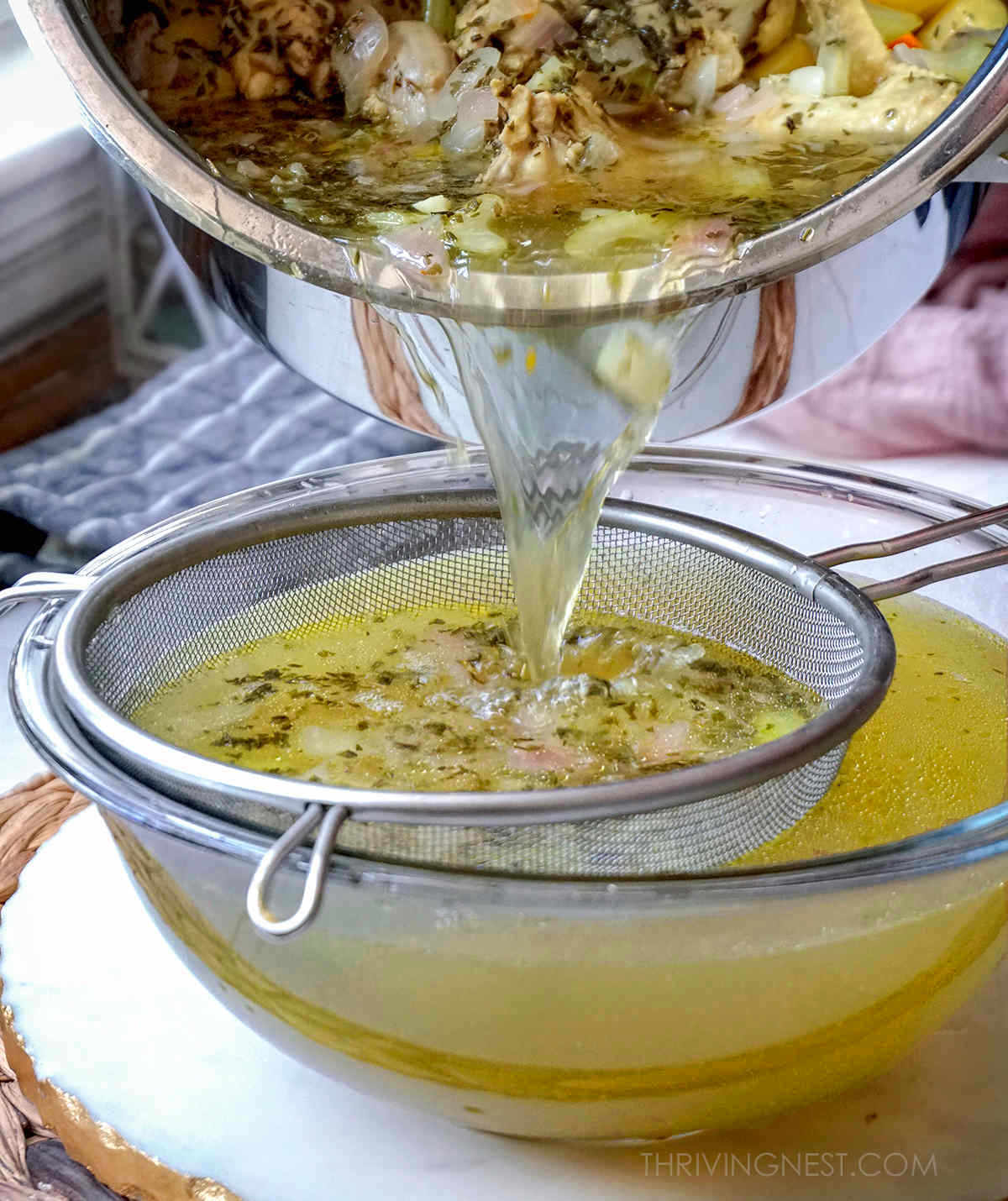
The baby broth can be used in so many ways:
- Boil the vegetables with it, or use as an oil substitution when cooking;
- Use in soups as a base: like Chicken Soup or vegetables soups (Butternut Squash Soup)
- Add in sauces as the liquid ingredient;
- Mix into salad dressings;
- Reheat leftovers, add instead of water to produce steam.
Baby Broth (Stock) With Chicken Bones
The best homemade chicken stock relies heavily on chicken bones which provide nutrients, collagen and body but it may lack flavor. A blend of both bones and some meat is perfect in terms of body and flavor. The added vegetables and herbs will provide a nice background flavor without adding any salt or spices.
Baby Stock / Baby Broth FAQ
The broth is made from simmered meat (no bones) and vegetables whereas stock is made from bones, connective tissues and cartilage along with aromatics and vegetables. The stock is also thicker, due to the collagen protein that seeps out of the bones during cooking.
A good broth is light on the stomach and the digestive system of a baby and contains many minerals and vitamins. A bone broth also has mild anti-inflammatory effect. It’s liquid form makes those nutrients more absorbable by your baby’s body. Bone broth is particularly beneficial for those babies who are intolerant to milk, since it provides calcium. It is also full of collagen to support growing bodies.
The broth or stock is great for babies starting solid food at around the 6 month mark as a supplement to breast milk and other solid foods.
Yes, if your baby is ready for solid foods. But keep in mind that a baby’s digestive system is mature enough to handle solids at around 6-months of age.
Bone broth can be used as a base for many baby foods. Add it to puree, sauces and soup. Some parents choose to feed the broth to their baby in a bottle, sippy cup or with a spoon by itself.
You’ll want to start with just one tablespoon and gradually increase to 2-3 tablespoons when the baby is ready for food intake increases.
Chicken broth / soup (especially when made with added bones) may be a great way to boost the baby’s immune system while sick and has been found to be beneficial for symptomatic upper respiratory tract infections due to it’s anti-inflammatory effect. The bone broth also contains glutamine which helps support a fragile intestinal lining and skin related issues like eczema, hence the bone broth became the main food used in the GAPS diet protocol.
This post may contain affiliate links. To read the disclaimer policy See This.
Best chicken parts for a gelatinous chicken stock: parts with many joints and bones like chicken necks, backs, feet and wings.
I prefer to buy a whole chicken and use the parts specified above (the combination of skin, cartilage and meat is perfect for a flavorful stock). The rest (chicken breast and thighs) are frozen for later meals.
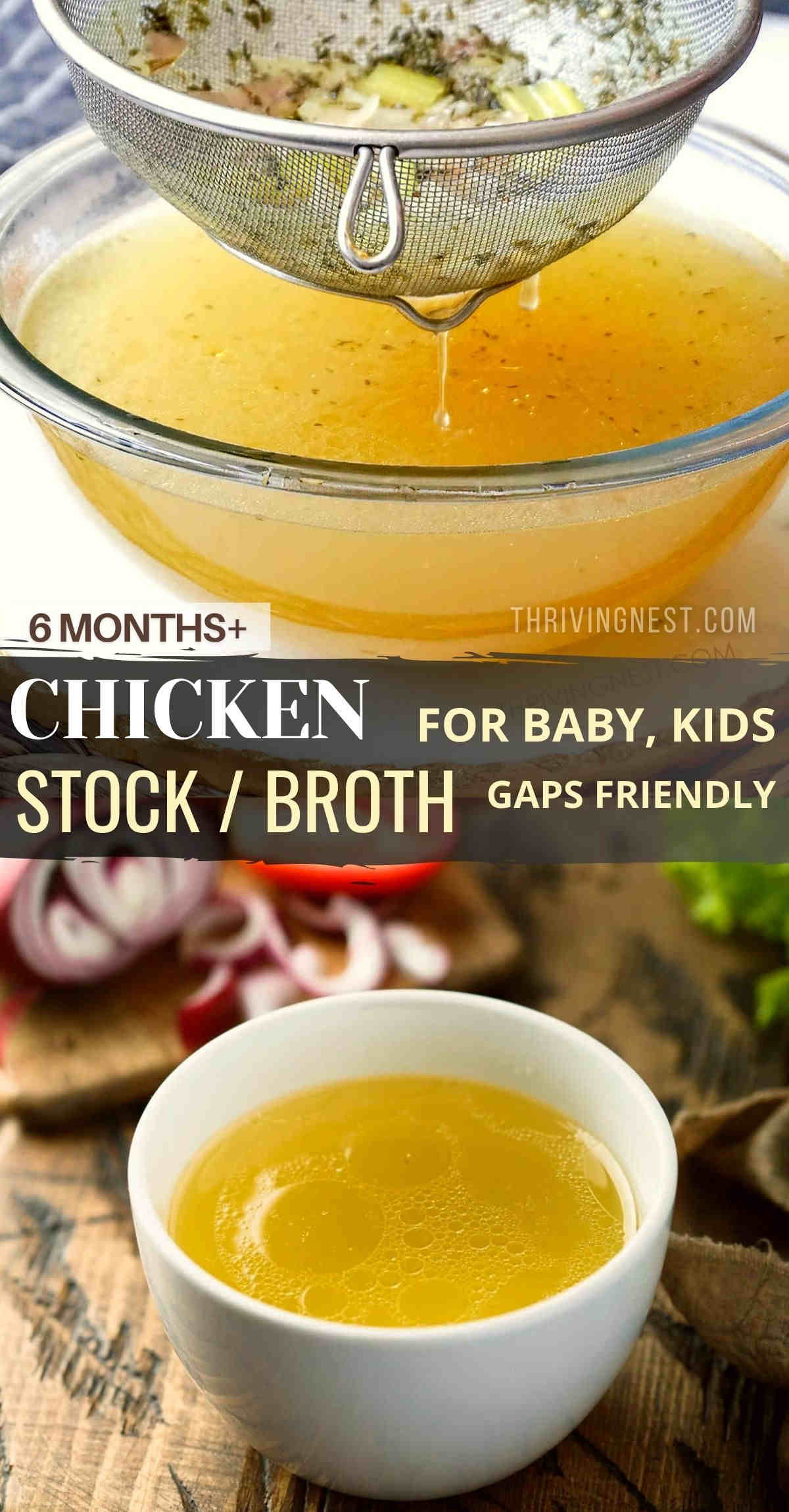
Baby Chicken Stock / Broth Ingredients
- A whole chicken (thighs, drumsticks and breast removed for other recipes). The back (carcass), neck, feet and wings will be used for stock. If you intend to make a simple chicken broth for your baby, then you can use just the meat (thighs, breasts or wings).
- Carrots – brings sweetness, color and flavor to the stock.
- Onion – freshly chopped not powder (gives depth of flavor).
- Celery – stalks or root, it adds flavor, savoriness and a pleasing bitterness in a similar way that bay leaf does.
- Garlic – use fresh cloves, no the powder (used for flavor).
- Thyme (fresh or dry) – is peppery and earthy adding a spicy note without adding black pepper.
- Parsley (dry) – brightens flavors and adds balance. There’s really no need to use fresh parsley, as much of the fresh, grassy flavors will be destroyed during the long simmering.
- Bay leaf (fresh or dry) – with an almost minty flavor and subtle hints of black pepper – adds another layer of flavor.
- Filtered water – filter your water if you don’t drink tap water.
See full ingredient list with measurements below in recipe card.
How To Make Chicken Bone Broth For Babies | Kids
1. Dismember a chicken and get the parts you need: the back (carcass), neck, feet and wings, wash thoroughly in cold water. Another method to ensure a clean crisp stock is to blanch (plunge in boiling water) briefly the bones and meat first and discard the water. Then add clean water and bring to a boil. Meanwhile prepare all vegetables.
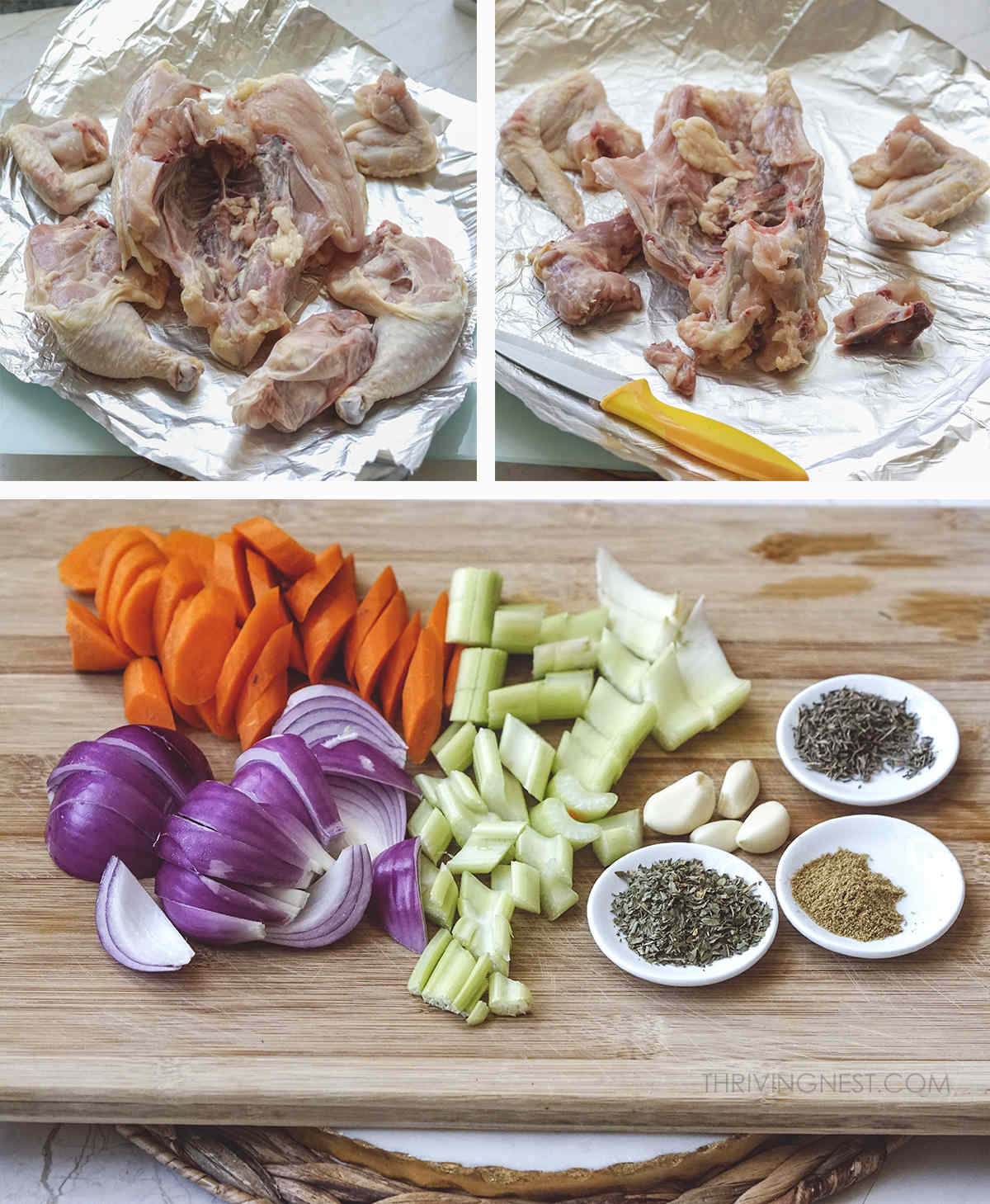
2. Add the bones and other parts to a large pot with one to two times their weight in water, I usually use about 4-5 quarts of water. Bring to a low simmer, constantly skimming off the scum for the first 1 hour. Then add the dried herbs (thyme, bay leaves, parsley).
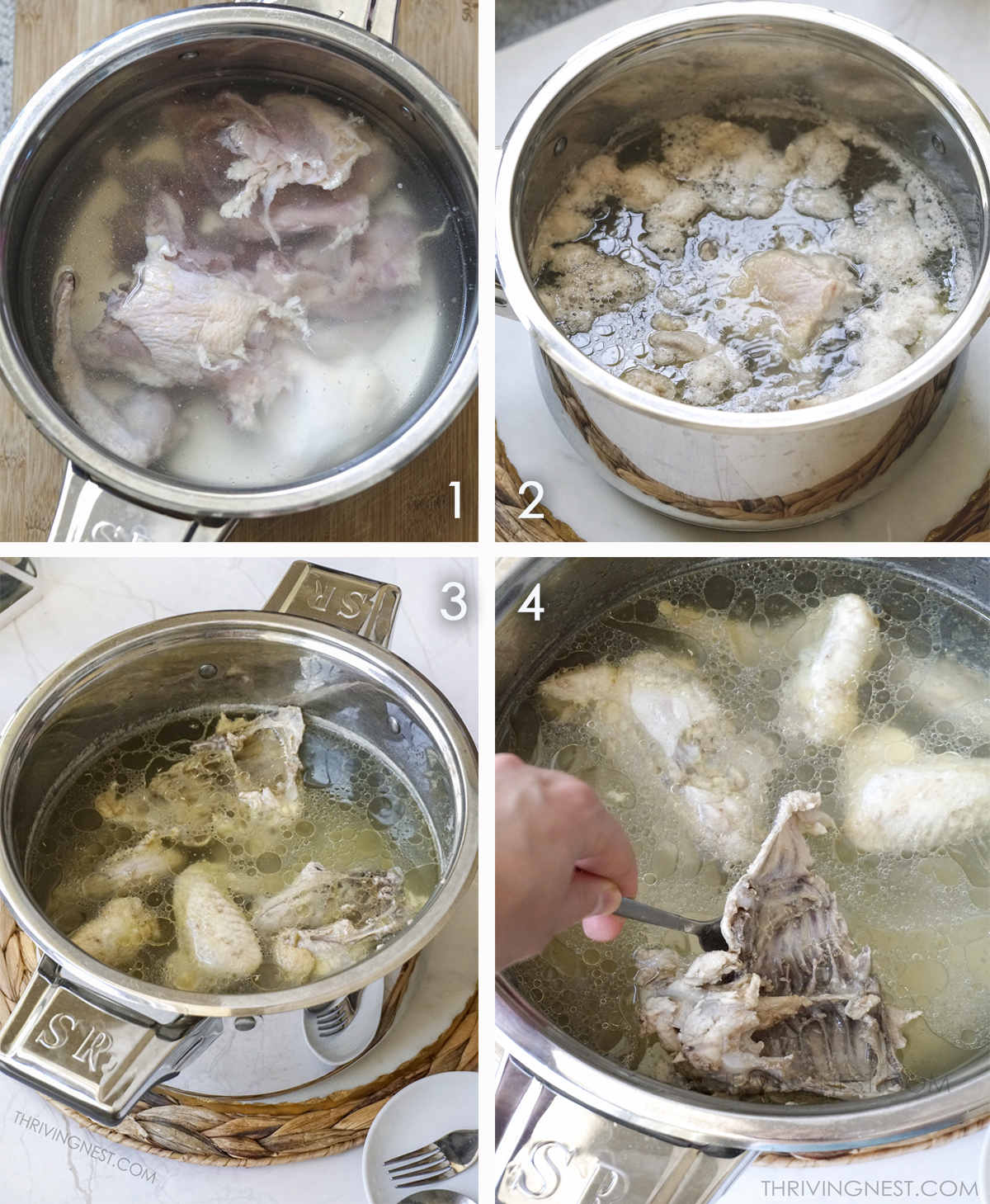
3. Take out the cooked meat from bones after an hour or so, otherwise the protein will disintegrate and will not be good for consumption (you can add it to the soup later or other recipes). Throw the bones back in and simmer for about 4-5 hours at very low heat. The water will evaporate but try to keep the level up (add if needed) so the bones are covered in water all the time.
4. For the last hour of simmering throw in the vegetables (roughly chopped). Simmering the veggies for too long will destroy their nutrients.
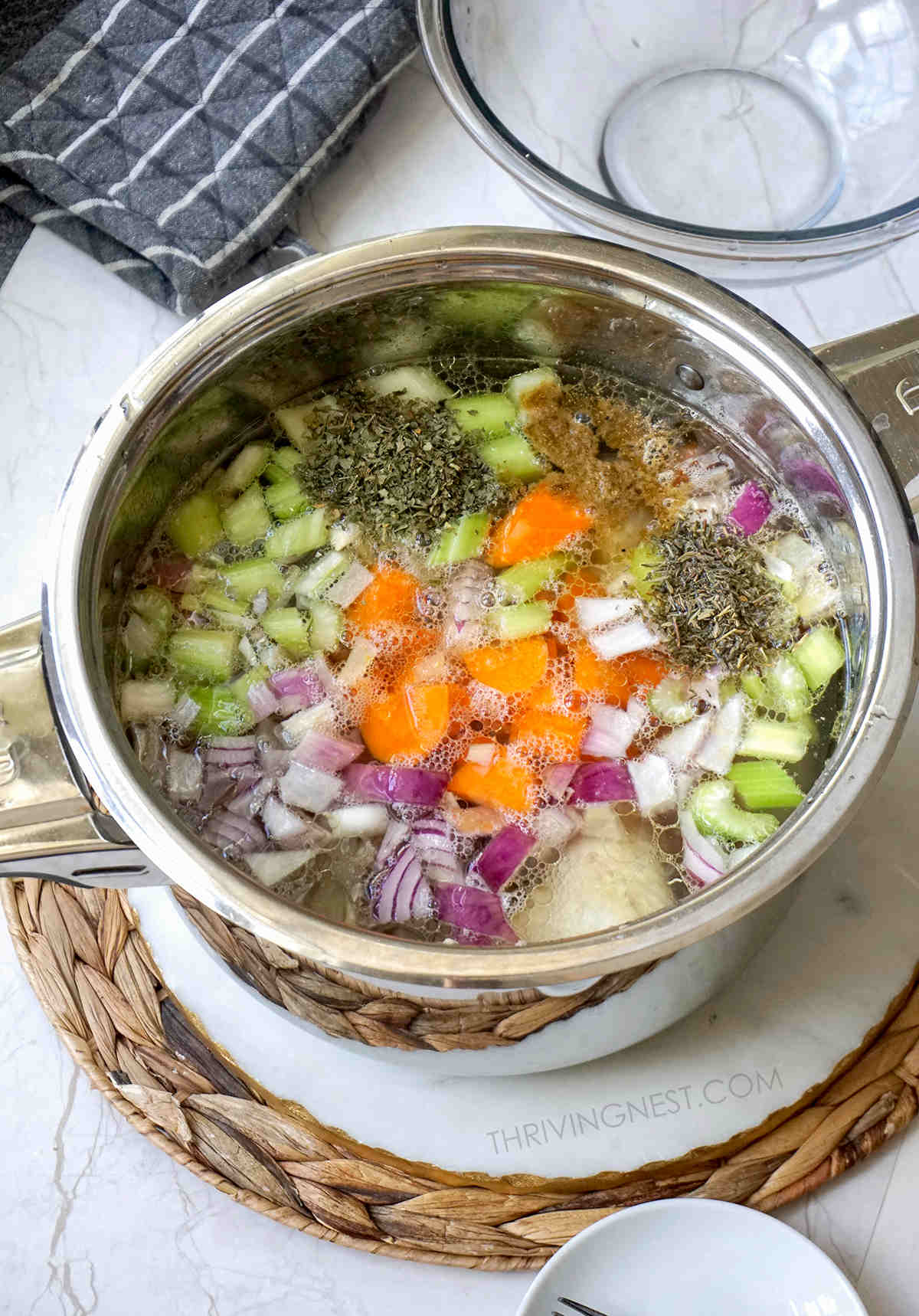
5. Let cool to room temperature. Strain the stock through a fine-meshed sieve (discard solids) and store in batches (use jars, cups or freeze large ice cubes then transfer in zip loc bags).
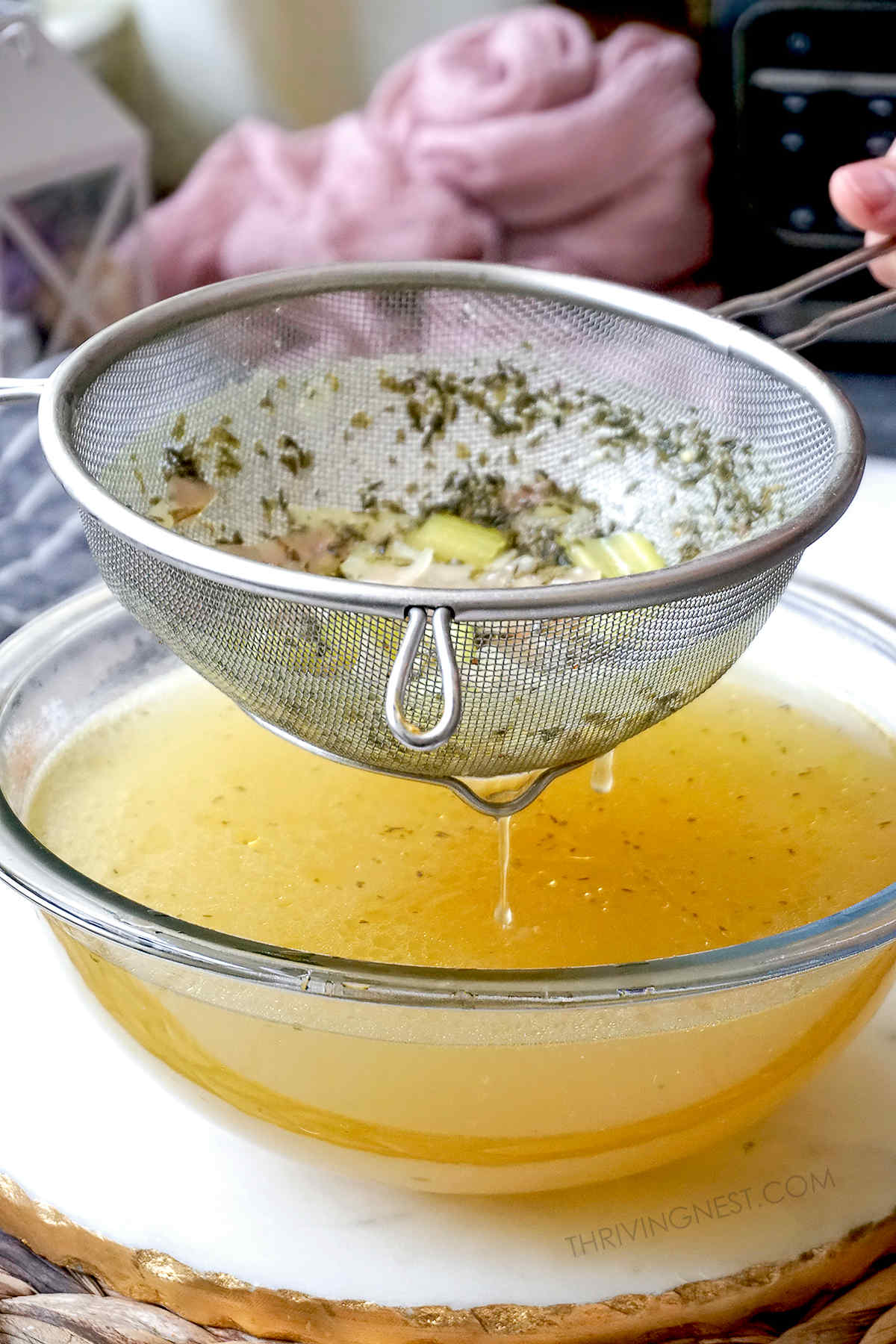
How To Make A Meat Based Chicken Broth For Babies
- Use the chicken breast, the wings, the thighs or a combination of those. Wash thoroughly, cover with water, bring to a boil and remove the foam until there is none.
- Add the aromatics and the vegetables and simmer similarly as the bone based stock but only for about an hour.
- Remove chicken from stock and let cool.
- Finely strain the vegetables and herbs out of your stock. Store.
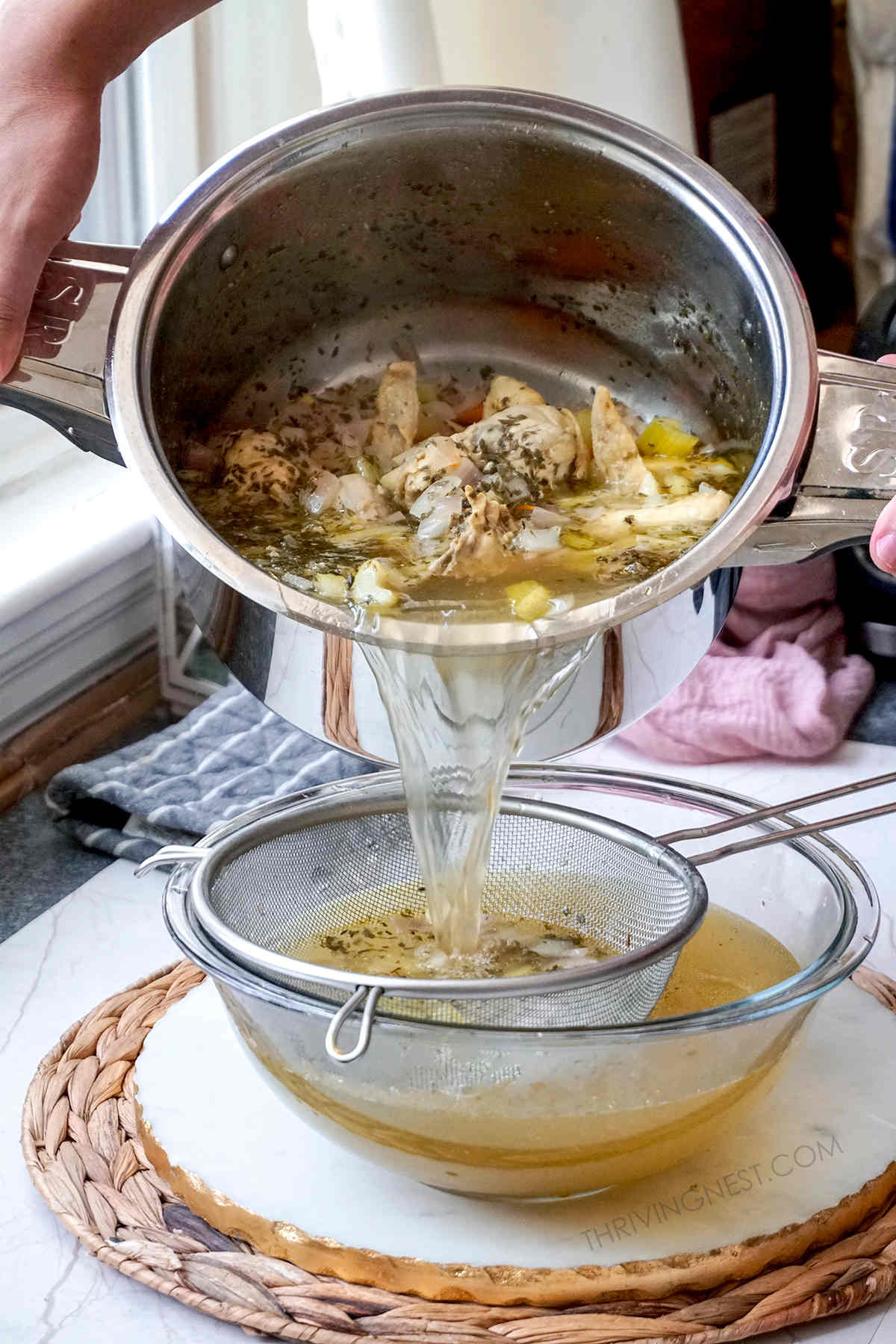
Tips For A Perfect Chicken Stock (Bone Broth)
- Add the herbs right when you start making your stock – use dry herbs – the nutrients and flavors will be destroyed during the long simmering time. frozen or fresh
- Add the vegetables at the last hour of simmering. The less they are exposed to heat the more nutrients will have.
- Start with cold water. This helps extract more collagen, giving the stock more body
- You can use leftover bones from roast chicken, but at least half (preferably 3/4) of the bones should be raw.
- Adding something acidic like vinegar or lemon to your stock helps extract the good stuff out of the bones.
How To Store
- Store leftovers chicken stock in the fridge for about a week.
- Freeze up to 3 months in an airtight container. Use glass jars, ice cube trays, muffin tins, or reusable silicone zip bags, they won’t leach harmful chemicals like plastics do.
- Thaw / reheat – just pop it out of the freezer and use with hot food.
Have you tried this chicken stock (broth) recipe? Your feedback is really helpful, please rate and leave a comment below recipe card!
More Chicken Recipes For Babies:
- Chicken Soup For Baby, Toddler, Kids (GAPS Friendly)
- Soft Chicken Meatballs For Babies, Toddlers, Kids (BLW)
- Chicken For Babies, Ways To Serve & Cook (BLW)
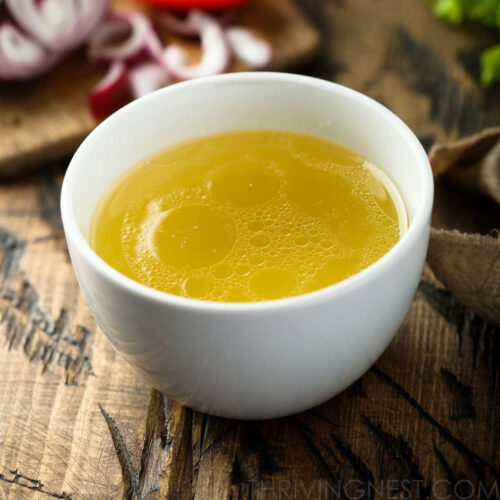
Chicken Stock | Broth For Baby / Toddlers / Kids
Ingredients
- 1 whole chicken (use organic free range chickens that are certified to be free of hormones and antibiotics.)
- 2 large carrots (roughly chopped)
- 1 large onion (red or white, roughly chopped)
- 2 stalks celery (or use celeriac (the root), roughly chopped )
- 3-4 cloves garlic (roughly chopped)
- 3/4 tsp dried thyme (or fresh sprigs (they are heat tolerant))
- 3/4 tsp dried parsley
- 1 bay leaf
- 4 quarts filtered water (3.8 liters)
Instructions
Prepare The Chicken
- Dismember a chicken and get the parts you need: the back (carcass), neck, feet and wings, wash thoroughly in cold water. Another method to ensure a clean crisp stock is to blanch (plunge in boiling water) briefly the bones and meat first and discard the water. Then add clean water and bring to a boil.
Cook The Chicken First
- Add the bones and other parts to a large pot with one to two times their weight in water, I usually use about 4 quarts of water. Bring to a low simmer, constantly skimming off the scum for the first 1 hour.
Add Aromatics
- Take out the cooked meat from bones after an hour or so, otherwise the protein will disintegrate and will not be good for consumption (you can add it to the soup later or other recipes). Throw the bones back in and add the dried herbs (thyme, bay leaves, parsley). Simmer for about 4-5 hours at very low heat. The water will evaporate but try to keep the level up (add if needed) so the bones are covered in water all the time.
Add The Vegetables
- For the last hour of simmering throw in the vegetables (roughly chopped). Simmering the veggies for too long will destroy their nutrients.
- Let cool to room temperature. Strain the stock through a fine-meshed sieve (discard solids) and store in batches (use jars, cups or freeze large ice cubes).
How To Make A Meat Based Chicken Broth For Babies
- Use the chicken breast, the wings, the thighs or a combination of those. Wash thoroughly, cover with water, bring to a boil and remove the foam until there is none.
- Add the aromatics and the vegetables and simmer similarly as the bone based stock but only for about an hour.
- Remove chicken from stock and let cool. Finely strain the vegetables and herbs out of your stock. Store.
Notes
Tips For A Perfect Chicken Stock (Bone Broth)
- Add the herbs right when you start making your stock – use dry herbs – the nutrients and flavors will be destroyed during the long simmering time. frozen or fresh
- Add the vegetables at the last hour of simmering. The less they are exposed to heat the more nutrients will have.
- Start with cold water. This helps extract more collagen, giving the stock more body
- You can use leftover bones from roast chicken, but at least half (preferably 3/4) of the bones should be raw.
Disclaimer: The information, including but not limited to, text, graphics, images and other material contained on this website are for informational purposes only and not intended for medical advice. Please refer to my full disclaimer for more info.
©ThrivingNest. Content and photographs are copyright protected and need prior permission to use. Copying and/or pasting full recipes to other websites and any social media is strictly prohibited. Sharing and using the link of this recipe is both encouraged and appreciated!

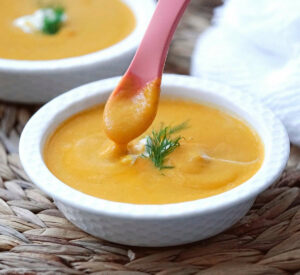




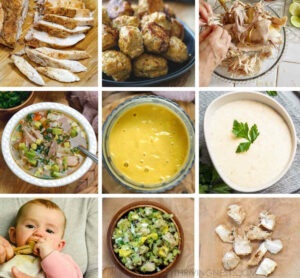
Can we use a slow cooker to make this? How long would you cook it in a slow cooker then?
I’m sorry I can’t help here, I don’t own a slow cooker.
Really good. I did it 3 times and I love it. The tips are great. Thank you.
Thank you for the recipe, I was looking for a GAPS compliant bone both recipe for my baby and this one sounds awesome!
I’m glad you found it useful!